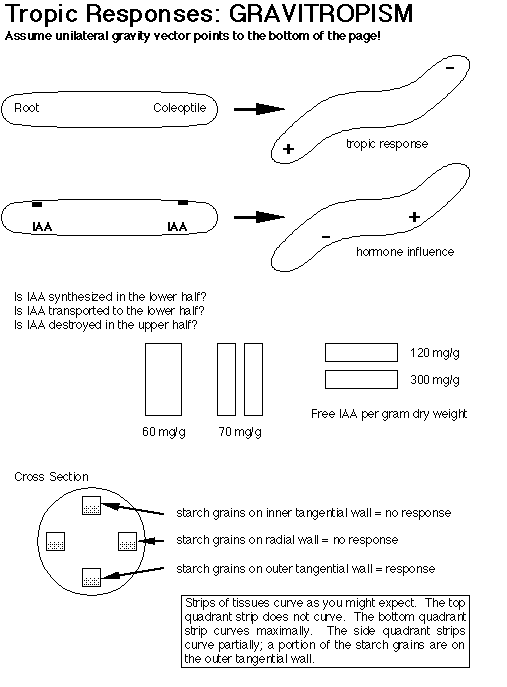
Our seedlings will not necessarily be sprouted in light. If seeds sprout under soil, they must orient themselves by another way. Seedlings grow with coleoptiles up and roots down. This response was originally called geotropism; of course surrounded by earth (geo), there would be no stimulus for a tropism. NASA which has funded most of the modern research has insisted on clear language. We now use gravitropism to describe the up-down growth response.
Clearly the root response (curving down) is called positive gravitropism (toward the head of the gravity vector) and the coleoptile response (curving up) is called negative gravitropism (away from the head of the gravity vector). How can one part of the seedling grow in one way, and another grow in a different way? Recall the differential responsiveness of tissues...this is a great example of how 1970's thinking helped explained older observations.
The concentration of auxin is different between the upper half and lower half of horizontally oriented seedlings. The higher amount of auxin in the lower halves of both coleoptile and root is essentially the same. The same is true about the lower concentrations in the upper halves of coleoptile and root. If the concentrations and differentials across coleoptile and root are the same, then the differential responses must be due to differential responsiveness (recall graph from previous lecture on phototropism!).
The more-sensitive roots are stimulated by lower levels of auxin...higher levels of auxin in lower halves result in less-stimulated growth...resulting in downward curvature (positive gravitropism).
The less-sensitive coleoptiles require higher levels of auxin to stimulate growth...higher levels of auxin in lower halves result in more-stimulated growth...lower levels of auxin in upper halves result in less-stimulated growth...resulting in upward curvature (negative gravitropism).

Peter Kaufman has investigated the gravitropic responses in oat shoots. When modern methods of analysis have been applied to this, the results are similar to those for phototropism. The levels of free auxin rise in both upper and lower halves, but the levels in lower halves are three-times greater. Transport and destruction are apparently not involved.
The mechanism for response is not much of a surprise. What about the perception?
There is no tip nor a photoreceptor. Obviously we need a gravity receptor. What could that be?
Starch grains fall within the cells in just about the right amount of time to explain the kinetics of the gravity response. These grains have been called statoliths (literally position stones). That makes perfect sense, and no other mechanism has ever been suggested or shown to respond in enough time for early growth kinetics.
Of course, the starch grains fall in cells in the upper half, the sides, and the lower half. So, the falling of starch grains against a cell membrane is perceived in cells all around the circumference of the plant tissue. Yet cells in the upper half respond with very little growth and those in the lower half respond with extensive growth in the shoots. How to explain that?
Obviously, the falling of the starch grains is not the decisive factor...it is which cell membrane the starch grains impinge upon that is important.
In cells of the upper half, the grains fall on the membrane of the inner tangential wall. This is apparently an unresponsive membrane.What is the response of the cells with the statoliths? These cells apparently produce the auxin necessary to explain the local growth response. Cells nearby, however, are the actual responding cells. In the case of oat shoots, the statocytes that contain statoliths are parenchyma cells located near the vascular bundles and a large group of collenchyma cells. It is the collenchyma cells nearby that respond to the auxin liberated by the statocytes. This satisfies the growth hormone concept.In cells of the sides, the grains fall mostly on the membrane of a radial wall. This too is apparently an unresponsive membrane. However, as grains accumulate, some will rest against the membranes of both outer and inner tangential walls. This explains the low-level of response here.
In cells of the lower half, the grains fall mostly on the membrane of the outer tangential wall. This is apparently the reponsive membrane. These cells respond maximally.
Go back to the Course Schedule.